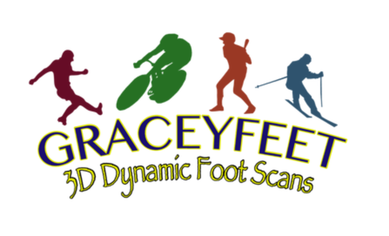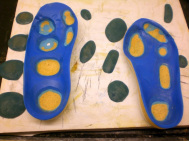|
"Dear Chris, I am in Greece and wearing my jogging shoes with the pad you made for (me) as well as the orthotic as I write this email. In fact the only reason that I am thinking about the pain I used to have is that I am writing you! Thank you, G.A."
The above is a pleasant and informative email sent to me that introduces my next topic quite nicely. How and Why the body is able to conform and tolerate an orthotic device to the point they are "forgotten" are questions clients often ask but receive few specific answers on from healthcare professionals. What my patients are mostly looking for is useful information, based in science, that explains why we recommend they slowly get used to their orthotics. Well, it's not for functional ability of the orthotic device to 'break-in', but for the body's comfort to increase compliance in using the device. I tell them, "The foot can get used to just about anything, but we want it to get used to the RIGHT environment." Here's HOW that happens: Nerves of sensation are found in abundance in the Dermis layer of the skin. Meissner Corpuscles are responsible for signaling light, fast touch. Pascinian corpuscles sense deep pressure and vibration. Free nerve endings are responsible for pain and temperature changes. Proprioceptive nerves sense positional and rotational changes at the joints. These nerves work independently and in groups to let the brain know what the physical changes of the skin are and where the limb is in space. Placing an orthotic under the foot and inside a shoe has been shown to alter joint position, plantar pressure distribution, and pressure magnitude. Changes in these variables are detected by the nerves in the foot and if an abrupt or large change is experienced for too long a time, a pain threshold may be reached. This means that a device may place the foot in a desired corrective position but may also induce a pain response if the brace is not anatomically correct and is not introduced slooooowly. So I do not say a word of the above to my client unless they ask in a way that leads me to believe they would understand those complex concepts. Instead a reply such as, ">>>To be continued<<< - CG
8 Comments
Let's start off by giving a few references:
Milani, TL, & Hennig, EM (1993). Pressure distribution under the foot at the take off in volleyball jumps and high jumps Fosbury Flop. In Biomechanics XIV, (pp. 874-875). Paris: International Society of Biomechanics. Energy absorption of different court surfaces: http://www.asbweb.org/conferences/1990s/1998/86/index.html Volleybal Biomech Differences btw Sand and Rigid surfaces in Squat Jump: http://www.ncbi.nlm.nih.gov/pubmed/15079993 Orthotics do have an effect on the angular alignment of the bones of the foot in stance and it is widely accepted that these changes translate to a change in plantar pressures and center of progression during gait. The degree or magnitude of effect on pain and function is not well known and published results are largely subjective or speculative. Too bad. But what we do know is that by altering the plantar pressures during gait, we can elicit the effect of breaking a player's cycle of loading the foot in a painful area and relieving an overused area of compensation. But what about the playing surface and how can we reduce the risk of injury occurring in the first place?? In Jumping, the softer and more compliant a surface is, the greater amount of force is transferred to the jumping surface. Additionally, the body will make angular compensations at the LE joints and hips to improve stability, increase extension moments, and launch during a jump. It would appear that the softer surface (Sand) reduces the likely hood of impact injuries but at the expense of increased loading of the support structures of the foot and ankle at angles that do not occur on a more rigid surface. Compensations such as these are highly individualized and each player will have their own method of positioning themselves for proper launch and landing. This would be enhanced in barefoot conditions v. shod. The lesson to take away here is that an orthotic can have very little effect on the alignment of the LE on a typical sand volleyball court. Depth of sand and a billion other assumptions are being made of course, but if a team is training on sand, they should schedule their matches for sand surfaces as the body will have learned to perform on that surface. A player may actually jump higher on rigid surfaces having trained on sand, but foot placement and impact forces will be dramatically different on the rigid court and an increase in the likelihood of injury may occur. Multi-surface training and an understanding of each individual's compensations to varying court surfaces are keys to injury reduction. An orthotic with good energy return, flex, support, and a shock-absorbing sockliner should help a player adjust to the changes in plantar pressures and bony alignments that are found going from sand to more rigid court surfaces. Soon...
Additional content: Topical Article Page Information on New Techniques New Equipment Page New Sponsors Arena New Events Calendar |
Chris Gracey MPT, Cped
Archives
October 2015
Categories
All
|
Follow Graceyfeet on Facebook and Twitter


 RSS Feed
RSS Feed
